The Greek Economy
Unprecedented fiscal consolidation achieved, Structural reforms in all fronts implemented, Focus now on competitiveness and growth.
The Greek economy grew fast during the two decades that preceded the current crisis. Between 1990 and 2009, the average growth rate in Greece was 3.1% compared to average rates of 2.3% and 2.1% for the EU15 and EA12, respectively. The adoption of the common currency had a particularly strong positive effect on the growth rate, mainly due to the low interest rates and the stable macroeconomic environment that were associated with it.
High Growth Rates
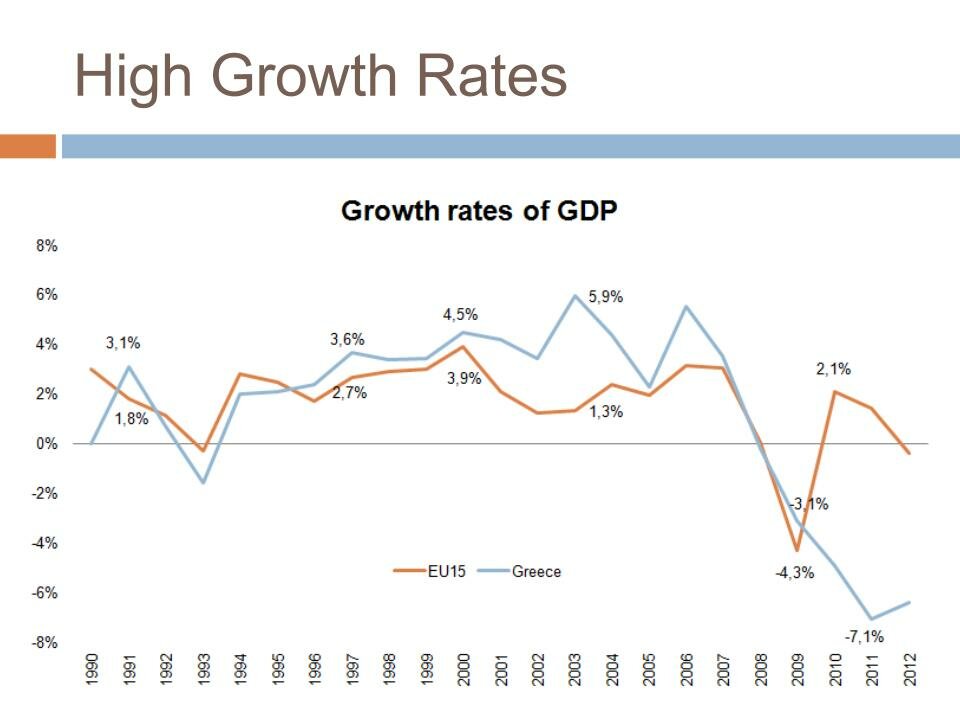
However, this growth was not based on sustainable factors but was mainly fueled by domestic consumption financed by external borrowing. As a consequence, the stock of the country’s debt increased significantly while the balance of payments deteriorated. In late 2009 it became clear that the situation was unsustainable and Greece’s fiscal deficit was going to skyrocket unless drastic fiscal consolidation measures were adopted. In 2010 credit rating agencies, which during the 2000s had been particularly sluggish to discount Greece’s accelerating loss of competiveness, downgraded Greece sharply and the country was cut off from the international capital markets.
Fiscal Adjustment
Between 2009 and 2012, the primary deficit (as defined by the economic programme)declined by 9.0% of GDP – the biggest and fastest ever recorded adjustment by an OECD economy (Graph 1). In terms of cyclically adjusted primary balance, a 4.3% primary surplus has been achieved in 2012. In 2013, a primary surplus of 0.4% of GDP is being projected, which in cyclically adjusted terms accounts for a 6.4% surplus of GDP – the largest in the EU-27.
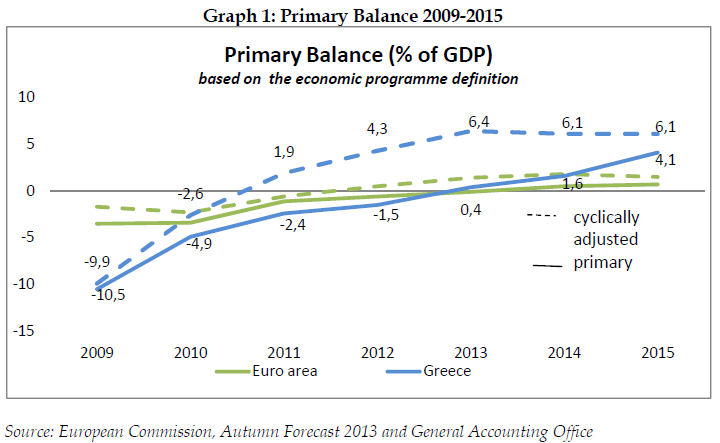
According to the European Commission, between 2009 and 2012 Greece’s structural budget balance declined by 13.8% of GDP and in 2013 there will be a structural surplus equal to 1.2% of GDP– the largest in EU-27 (Graph 2).
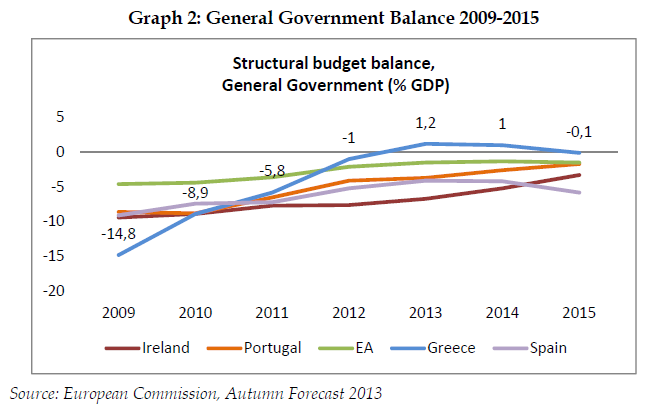
The General Government revenues rose as a percentage of the GDP despite the deep recession. More specifically, they accounted for 38.4% of GDP in 2009, 40.6% of GDP in 2010, 42.4% of GDP in 2011 and 44.6% of GDP in 2012. On the other hand, the General Government expenditures declined from 124.7 bn euros in 2009 to 114.0 bn euros in 2010, 108.3 bn euros in 2011 and 103.9 bn euros in 2012.Overall, by the end of 2013 three-quarters of the required fiscal adjustment needed to reduce debt to sustaina ble levels by 2020 have been completed. The fiscal consolidation measures adopted were almost equally split between e xpenditure cuts and tax increases. In particular, as depicted in Graph 3, in the first and second year of the programme the adju stment was broadly revenue based, but tu rned heavily in favour of the expenditure side during 2013-14. The 2013-14 pack age is heavily frontloaded, with almost 5.6% of GDP in measures undertaken in 2013, a little over 2% GDP remains to be applied in 2014.
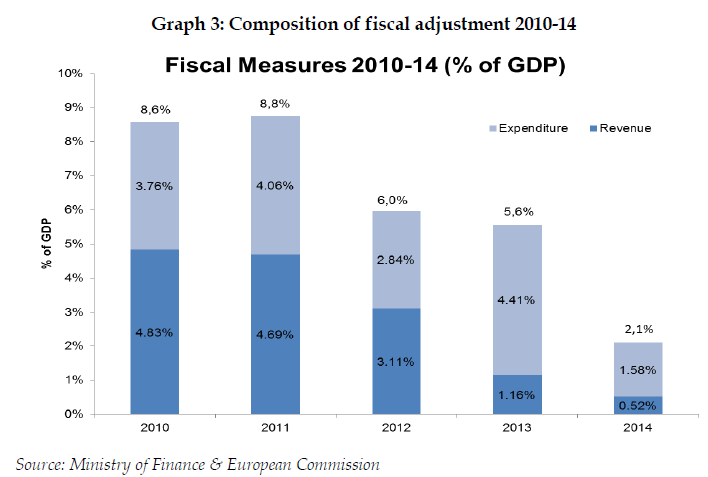
When assessing the effectiveness of consolidation efforts by examining the improvement in the estimated structural balance, the consolidation effort made in Greece from the beginning of the adjustment program, 17.5 percentage points improvement in the cyclical-adjusted primary balance, is the largest consolidation among advanced economies, but also the fastest, with an annual rate of 4.4 percentage points of GDP on average (Graph 4). Even though Greece has commenced its current episode relatively late (2010) compared to other countries that participated in formal as sistance programs, performs not only the deepest but also the fastest consolidation effort across the EU countries (Graph 5).
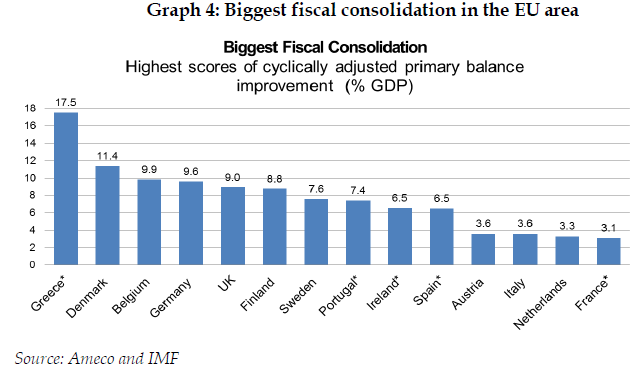
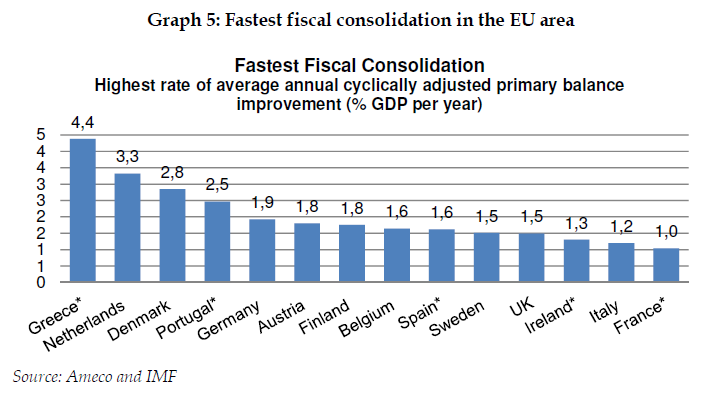
The State Budgets for 2013 and 2014 have incorporated the largest part of the fiscal measures envisaged in the Medium-Term Fiscal Strategy (MTFS) fra mework for the period 2013-2016. In par allel, Greece continues to implement the economic policy programme with support from the EC, ECB and IMF, and by applyin g a wide range of measures (strict expen diture controls and improvements in tax compliance) to consolidate public finances, has managed to outperform the program targets with regards to the fiscal consolidation in a short time span. The elimination of the twin deficits that characterized the Greek economy for many years, in conj unction with an increase in competitiveness as a result of institutional and struct ural reforms is expected to lead to positive growth rates, while safeguarding the stability of the financial sector and restoring Greece’s credibility for private investors.
NOTES
- The primary balance excludes interest payments from expenditure. It provides an indicator of current fiscal effort, since interest payments are predetermined by the size of previous deficits. For countries with a large outstanding public debt relative to GDP, achieving a primary surplus is normally viewed as important, being usually necessary (though not sufficient) for a reduction in the debt/GDP ratio.
- Cyclically adjusted or structural balance is a measure of the fiscal position that is net of the impact of macroeconomic developments on the budget. Essentially, calculation of a cyclically adjusted or structural balance involves an estimation of what revenues and cyclically adjusted expenditures (and, thus, the deficit) would be if the economy were at its potential or - for some measures of the structural balance - its trend output, rather than its actual output.
- Program definition: The main differences of the program definition compared with ESA-95 definition are the exclusion from the program definition of the Agreement on Net Financial Assets (ANFA) and the Securities Markets Programme (SMP) profit transfers, most sales of non-financial assets, and costs related to bank resolutions and recapitalizations.
At that stage, the Greek government agreed with its European Partners and the IMF on a multiannual package providing the necessary funding to Greece and assuring that the necessary reforms would be implemented so that Greek economy would return to a sustainable growth track. The total amount of the financial support reached approximately €200 billion and was followed by a strong conditionality with respect to the necessary structural reforms that Greece had to implement. After almost 4 years of reforms and fiscal consolidation, the level of adjustment is impressive by any means of comparison.
In terms of fiscal consolidation, the general government deficit declined sharply from a 15.6 % of GDP in 2009 to a projected 4.1 % of GDP in 2013 producing, for the first time after almost a decade, a primary surplus. Greece’s fiscal consolidation effort was the largest ever recorded by a developed country and, remarkably, it was achieved despite a sharp decline in output.
Coming to the external adjustment, the negative gap in the current account, which reached 14.9 % of GDP in 2008, has been almost entirely eliminated by 2013. This was due to strong gains in competitiveness (Unit Labour Cost is now lower than at the time Greece joined the euro), a sharp decline in imports and a gradual rebound in the export activity.
Current Account Deficit Declining
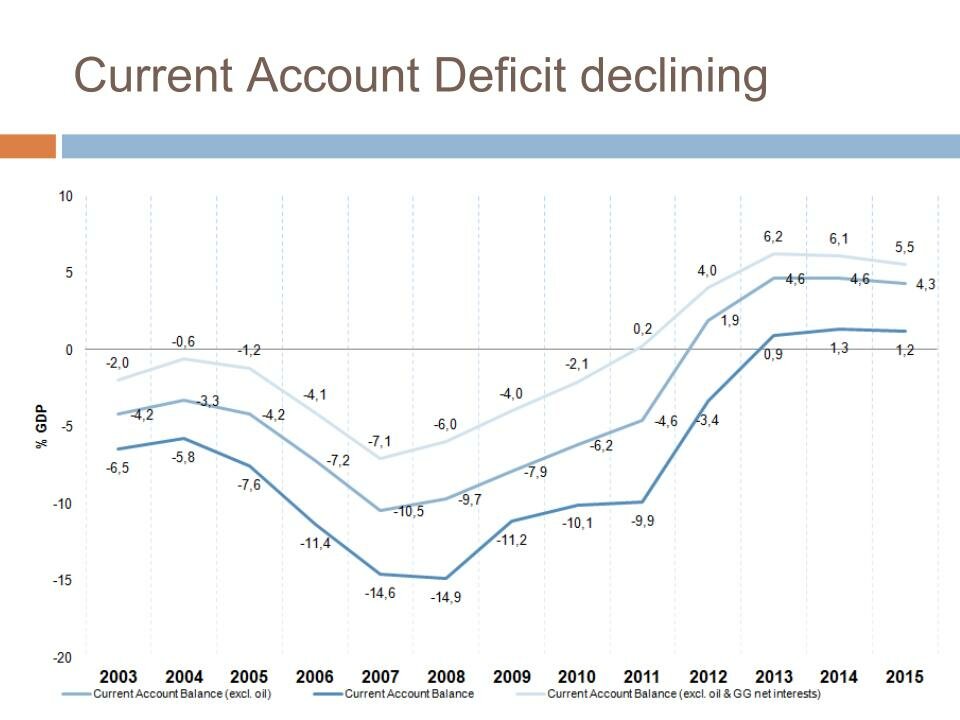
In the structural reforms front, Greece implemented a series of reforms that helped to close the competitiveness gap and create an investment-friendly environment.
Selected structural reforms
- Pension reforms: average pension income cut by 21% and high-end pensions by over 40%; the statutory retirement age raised to 67 years across the board (40 years of work required for full pension); system among the most viable in EU according to EC peer review; pension benefits tightly linked to lifetime contributions.
- Labour market reforms: 22% reduction in minimum wage (32% for young workers) and new minimum wage setting mechanism; average public sector salary cut by 23% between 2010-12; reduced length of collective contracts; removal of “tenure” in all existing legacy contracts; primacy of firm level agreements over other collective agreements; cut in severance payments.
- Public Administration reforms: public sector employment cut from over 950.000 in 2009 to less than 750.000 in 2012 and projected to fall by further 90.000 (13%) by 2016 (IMF estimate); introduction of unified wage grid and staffing plans for the entire public sector with evaluation of all employees by end-2013; establishment of mobility scheme and mandatory exit targets.
- Health Care reforms: eight social insurance funds merged into one (EOPYY) that covers almost the entire population (9 million insured and dependents); introduction of automatic claw-back mechanisms for pharmaceuticals, diagnostics and private clinics to ensure compliance with spending ceilings, monitoring of hospital performance and wider use of generics/off-patent pharmaceuticals (with benchmarking to EU); establishment of e-prescription system for pharmaceuticals and increase in co-payments.
- Social Protection reforms: rationalization of social benefits; increased use of meanstesting for the provision of benefits; introduction of policies targeted at long-term unemployed.
- Fiscal Structural reforms: strengthened fiscal framework (medium term fiscal framework, binding expenditure ceilings, expenditure monitoring mechanisms); automatic corrective mechanisms when targets are missed for Central Government, State-owned Enterprises and Local Government.
- Tax reforms: tax code simplification; repeal of the Code of Books and Records; compulsory electronic submission of tax declarations; new IT system interconnecting all tax offices; full scope audits according to risk based criteria; auditing rights outsourced to private auditing companies.
- Tax Administration reforms: establishment of a semi-autonomous post of General Secretary for Tax Administration with sweeping powers to tackle tax evasion legacy; compulsory rotation of the heads of local tax offices; merger of tax offices; creation of 23 tax-related court units.
- Business environment: “one-stop-shop“ to set up a business in 1 day; removal of the 30 most important barriers to entrepreneurship; fast track process for investments.
- Regulated professions: elimination of minimum fees for services; abolition of cabotage (home porting) rules related to cruise vessels flying non-EU flags; liberalization of road haulage sector; repeal of unnecessary restrictions in retail (sanitary, labour, and transport); liberalization of fuel and energy markets.
- Privatizations: privatization programme reinvigorated with recent privatizations including sale of State gaming monopoly and the gas distribution company.
Important reforms were undertaken in almost all areas of economic activity, with the most significant of them implemented in the labour market, the pension system, the health system and the tax administration. As a consequence of these reforms, in recent years the OECD consistently ranks Greece as the most responsive of its member countries in adopting its growth-friendly recommendations.
Responsiveness to "Going for Growth"
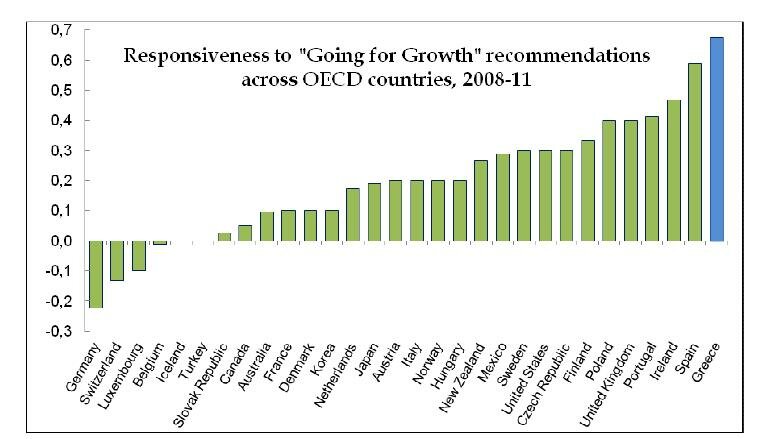
Source: OECD, Going for Growth 2012
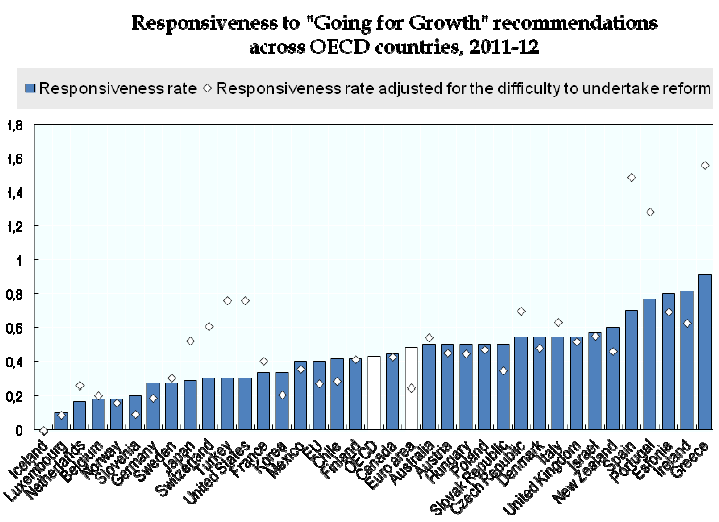
The financial sector was hit hard during the crisis and its deposit base shrank. Its rebalancing is currently underway. The systemic Greek banks have been recapitalized, while smaller ones were restructured or resolved. Savings are gradually returning to the banking system.
Financial sector
During the run-up to the crisis, Greece’s financial sector was particularly strong: a high credit growth was achieved and sustained, Greek banks were expanding abroad, and contrary to the experience of other European countries, domestic financial institutions were not affected to a large extent by the international financial crisis.
However, the deep recession that followed along with the high uncertainty that was created, had a large impact on the financial sector, especially the banking system. Uncertainty was especially reflected in the large outflows of bank deposits that took place up to June 2012. Furthermore, Greek banks incurred losses from the PSI programme, while the number of non-performing loans increased considerably. The above factors aggravated the already tight credit conditions in the economy. As a result, annual rates of growth of credit to the domestic private sector have been negative since the beginning of 2011, thus contributing to a further slowdown in economic activity.
Recently, the situation has started to improve noticeably, as decisive steps have been taken towards the stabilization of the financial system and the creation of a sound and competitive banking sector.
Throughout the crisis, strong bank liquidity support measures have been provided, and are being provided, from the Greek state. In particular, State guarantees which do not have a cost for the State budget, have been used to obtain Eurosystem liquidity (either through the use of the main refinancing operations or the use of Emergency Liquidity Assistance).
In 2010, the Hellenic Financial Stability Fund was established as a safety net for the banking sector. It was provided with €10 billion to back stop for capital support. Following PSI, the amount was raised to € 50 billion.
Since then, the recapitalisation of the four core banks has been completed and the Hellenic Financial Stability Fund (HFSF) has become their largest shareholder. Three of them remained under private control after fulfilling the prerequisite to raise at least 10% of their capital needs from private participation, while one was fully recapitalised by the HFSF. It is expected that, gradually, the four core banks will be able to enter again the international capital markets.
In addition, the banking system has been consolidated and is currently under restructuring; strong institutions are formed with the completion of domestic mergers.
Confidence is gradually restored. Since June 2012 net inflows of deposits have been recorded. It is expected that the continuing return of deposits will contribute to the improvement of the liquidity conditions and will give a boost to the real economy.
However, this impressive adjustment was accompanied by significant socio-economic costs. Since 2009, output declined by over a quarter; a decline not experienced by any developed country apart from the US even during the time of the Great Recession. Although the unemployment rate has now stopped rising, it has reached levels that are unprecedented for a developed country. Currently, it stands at above 27%, while youth unemployment hovers around 60%. Approximately two thirds of the unemployed have been unemployed for over a year. Partly as a result of this and partly due to the fact that, on average, the disposable income of the population declined by over a third since the onset of the crisis, almost 35% of the population is classified by EUROSTAT as being at risk of poverty or social exclusion.
There is light in the end of the tunnel though, and all these efforts and sacrifices are starting to pay off. According to the latest estimates, 2014 will mark the exit of the country from the six years recession, while in the following years, Greece will experience robust, gradually rising growth rates that will be based on sustainable factors such as exports, tourism, innovation and foreign direct investment, while major structural reforms are planned for the product market, the business environment and public administration. On these grounds, one of the most worrying macroeconomic figures, the debt to GDP ratio, will radically de-escalate, while unemployment is also expected to enter a downward path.




